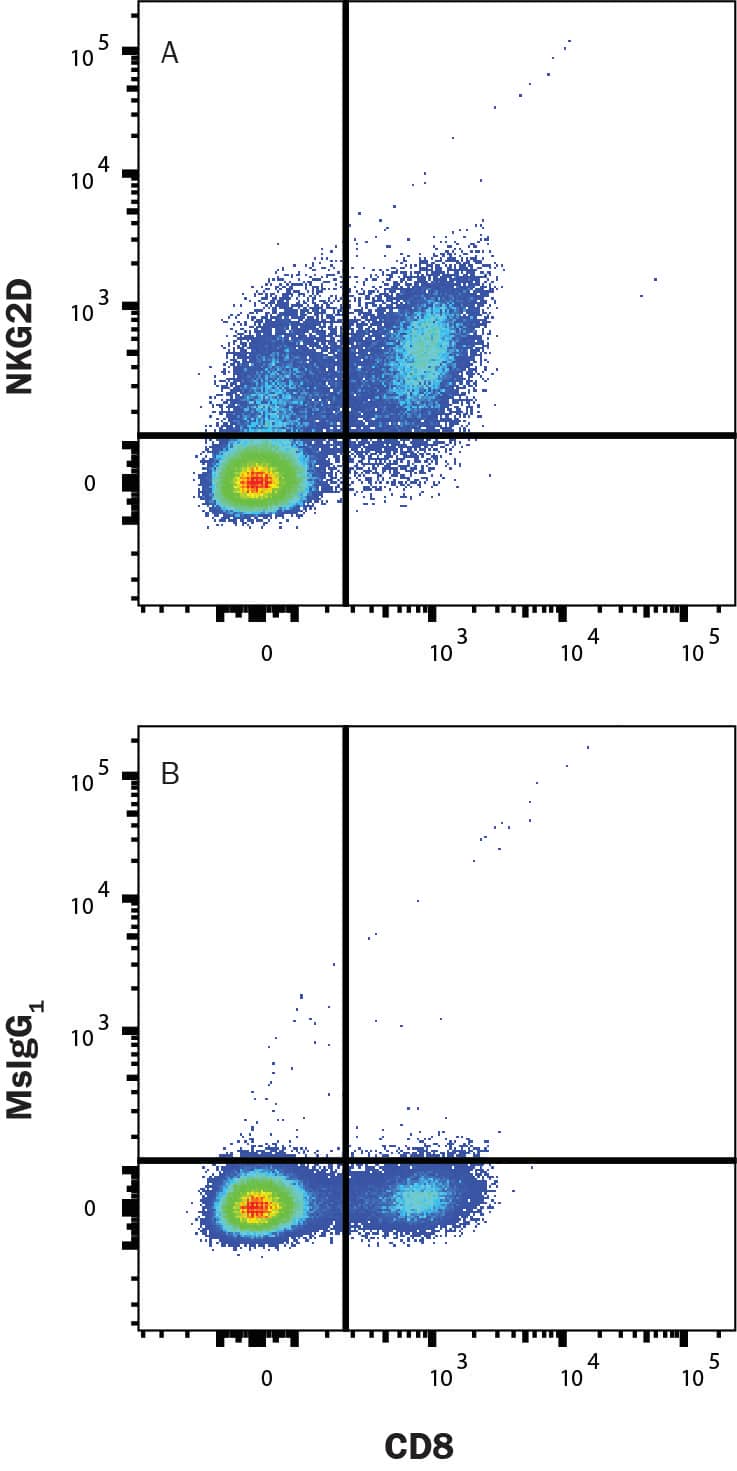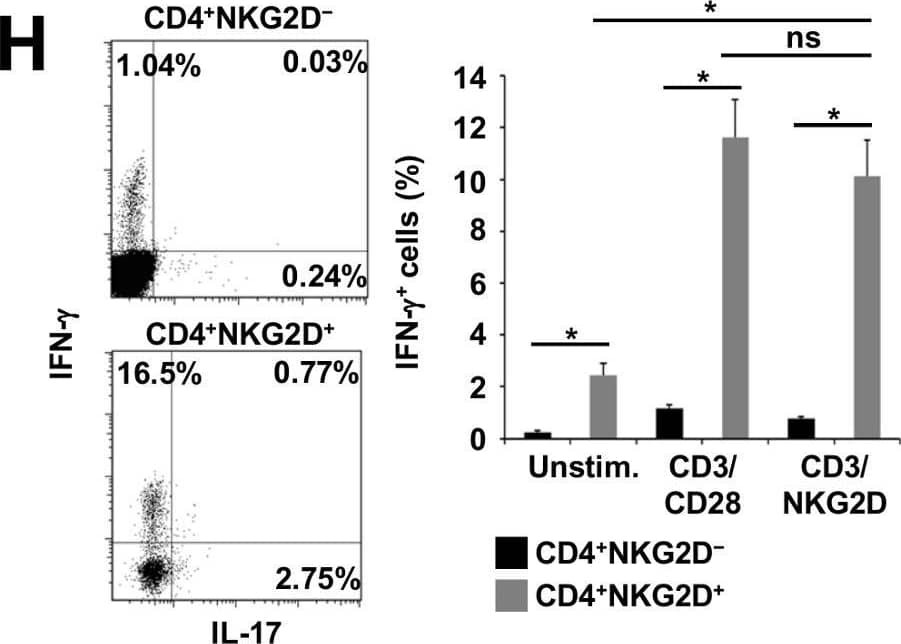Human NKG2D/CD314 Antibody
R&D Systems, part of Bio-Techne | Catalog # MAB139


Key Product Details
Species Reactivity
Validated:
Cited:
Applications
Validated:
Cited:
Label
Antibody Source
Product Specifications
Immunogen
Specificity
Clonality
Host
Isotype
Endotoxin Level
Scientific Data Images for Human NKG2D/CD314 Antibody
Detection of NKG2D/CD314 in Human PBMCs gated on CD3- cells by Flow Cytometry.
Human peripheral blood mononuclear cells (PBMCs) gated on CD3- cells were stained with Mouse Anti-Human NCAM-1/CD56 APC-conjugated Monoclonal Antibody (Catalog # FAB2408A) and either (A) Mouse Anti-Human NKG2D/CD314 Monoclonal Antibody (Catalog # MAB139) or (B) Mouse IgG1 Isotype Control (Catalog # MAB002) followed by anti-Mouse IgG PE-conjugated Monoclonal Antibody (Catalog # F0102B). View our protocol for Staining Membrane-associated Proteins.Detection of NKG2D/CD314 in Human PBMCs by Flow Cytometry.
Human peripheral blood mononuclear cells (PBMCs) were stained with Mouse Anti-Human CD8 APC-conjugated Monoclonal Antibody (FAB1509A) and either (A) Mouse Anti-Human NKG2D/CD314 Monoclonal Antibody (Catalog # MAB139) or (B) Mouse IgG1 Isotype Control (MAB002) followed by anti-Mouse IgG PE-conjugated Monoclonal Antibody (F0102B). Staining was performed using our Staining Membrane-associated Proteins protocol.Detection of Human NKG2D/CD314 by Flow Cytometry
Multiple receptors and ligands are involved in NK cell-mediated lysis of activated CD4+ T cells.Role of (A) activating and (B) inhibitory NK receptors in NK cell degranulation. Left column: representative histograms (of n≥3) for surface expression of ligands on activated (thick black line) and resting CD4+ T cells (thin black line). Isotype-matched control Ig are represented by dashed line (activated CD4+ T) and filled histogram (resting CD4+ T). Middle- and right column: NK and CD4+ T cells were activated for 4 days in vitro as described, and co-cultured for 4 hours with 10 ug/mL mAb (or relevant isotype-matched control Ig). Degranulation is shown for CD56dim (middle column) and CD56bright (right column) NK cells. Representative histograms of surface expression of receptors on activated (thick black line) and resting NK cells (thin black line). Isotype-matched control Ig are represented by dashed line (activated NK) and filled histogram (resting NK). * P<0.05, ** P<0.005, *** P<0.001. (C) Sorted IL-2-activated CD56dim and CD56bright NK cells were co-cultured with 51Cr-labeled activated CD4+ T cells in a 51Cr-release assay with human IgG4 isotype control (•) or anti-NKG2A mAb (○). Data represents n = 3 experiments. Image collected and cropped by CiteAb from the following publication (https://pubmed.ncbi.nlm.nih.gov/22384114), licensed under a CC-BY license. Not internally tested by R&D Systems.Applications for Human NKG2D/CD314 Antibody
Costimulation of T Cells
CyTOF-ready
Flow Cytometry
Sample: Human PBMC
Western Blot
Sample: Recombinant Human NKG2D/CD314 Fc Chimera (Catalog # 1299-NK)
under non-reducing conditions only
Neutralization
Reviewed Applications
Read 3 reviews rated 5 using MAB139 in the following applications:
Formulation, Preparation, and Storage
Purification
Reconstitution
Formulation
Shipping
Stability & Storage
- 12 months from date of receipt, -20 to -70 °C as supplied.
- 1 month, 2 to 8 °C under sterile conditions after reconstitution.
- 6 months, -20 to -70 °C under sterile conditions after reconstitution.
Background: NKG2D/CD314
NKG2D, also known as CD314, is a type II transmembrane glycoprotein having an extracellular lectin-like domain. This domain lacks the recognizable calcium-binding sites found in true C‑type lectins and binds protein rather than carbohydrate ligands. Human NKG2D is expressed on CD8+ alpha beta T cells, gamma delta T cells, NK cells, and NKT cells. In mouse systems NKG2D also occurs on macrophages. Human ligands for NKG2D include MICA, MICB, and ULBP1, 2, and 3. Expression of NKG2D ligands occurs in epithelial cells, tumor cells and under conditions of stress or infection. NKG2D exists as a disulfide-linked homodimer that delivers an activating signal upon ligand binding. Signaling requires association with an adapter protein. Alternative splicing of the NKG2D mRNA results in isoforms with different cytoplasmic domains that can associate either with DAP12 to deliver a true activating signal or with DAP10 resulting in a costimulatory signal. NKG2D has been implicated in anti-tumor surveillance and the immune response against viral infection.
References
- Li, P. et al. (2001) Nature Immunol. 2:443.
- Steinle, A. et al. (2001) Immunogenetics 53:279.
- Cosman, D. et al. (2001) Immunity 14:123.
- Cerwenka, A. and L. Lanier (2001) Immunol. Rev. 181:158.
- Wu, J. et al. (1999) Science 285:730.
- Diefenbach, A. et al. (2002) Nature Immunol. 3:1142.
- Gilfillan, S. et al. (2002) Nature Immunol. 3:1150.
- Groh, V. et al. (2001) Nature Immunol. 2:255.
- Cerwenka, A. et al. (2001) Proc. Natl. Acad. Sci. USA 98:11521.
- Diefenbach, A. et al. (2001) Nature 413:165.
- NKG2D and its Ligands (2002) www.RnDSystems.com.
Long Name
Alternate Names
Gene Symbol
Additional NKG2D/CD314 Products
Product Documents for Human NKG2D/CD314 Antibody
Product Specific Notices for Human NKG2D/CD314 Antibody
For research use only


